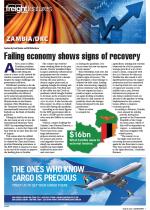Despite decades of attempts to diversify the Zambian economy, it remains highly dependent on copper, followed by non-traditional exports and gold.While exports of copper and non-traditional products increased between 2019 and 2021, gold exports were marginally down in 2021 compared to 2020.In response to growing export values and political change, the Zambian Kwacha has been steadily increasing in value.Gold exports down in 2021 compared to 2020.In 2021 copper accounted for around 77% of total exports.This puts Switzerland as the nominal major export destination for Zambian goods, followed by China, Singapore, Democratic Republic of Congo, South Africa, Tanzania and Zimbabwe, according to the Bank of Zambia’s Direction of Trade Report for the first quarter of 2022.The major copper traders are based in Switzerland.Copper is also listed as Zambia’s biggest import, with refined copper valued at $290m in 2020, followed by petroleum at $216m and then fertilisers. South Africa is the largest exporter to Zambia, valued at $545m in the first quarter of 2022, followed by China ($270m), Democratic Republic of Congo (DRC) ($212m), United Arab Emirates ($157m) and India at $128m. DRC exports are mainly copper which is processed in Zambia or is in transit, while the UAE is the major supplier of fuel.Other major exporters to Zambia are Japan ($67m), the United States of America ($60m), Botswana ($42m), the United Kingdom ($33m) and Namibia ($33m).Zambia’s regional trade with Southern African Development Community (SADC) countries totalled $648m, with Botswana ($42m) and Namibia ($33m) following South Africa’s $545m, according to the Bank of Zambia.

